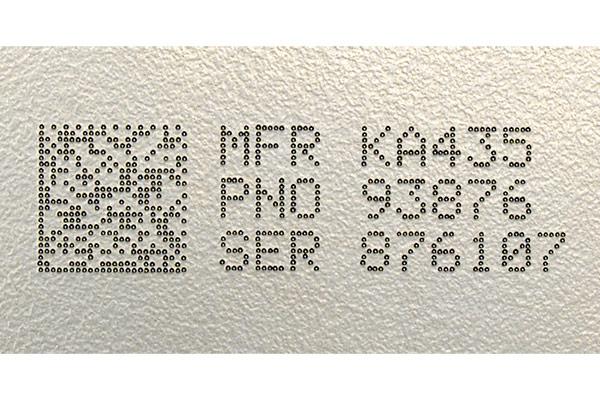Machine-readable identification holds the key to manufacturing efficiency.

Machine-readable identification is used to automatically identify a variety of products. Manufacturers are marking parts with machine-readable, permanent two-dimensional (2D) Data Matrix codes that are placed directly on the part itself. Then the part can be tracked throughout its entire life cycle, including manufacturing and supply chain operations. This is called Direct Part Mark Identification (DPMI), or Auto-ID. Established industry DPMI specifications and 2D marking guidelines are listed in the table below.
DPMI enables many tangible benefits for manufacturers. This practice:- Improves manufacturing process performance
- Identifies quality defects through in-service tracking
- Eliminates manual part data entry errors
- Supports data logging and automated data collection
- Increase yields, and
- As a result, reduces the direct and indirect costs of manufacturing.
The two-dimensional 2D Data Matrix code consists of an arrangement of small dots or squares, marked as either a square or rectangle. Invented by RVSI Acuity CiMatrix, the Data Matrix Code is a digital 2D, machine-readable symbology that is capable of storing large amounts of information within a small physical space. This code has been adopted by many industries, including aerospace, automotive, and electronic, as the best symbology for reliable, direct part marking.
Compared to linear barcodes, Data Matrix encodes much more data — 25 to 100 times more information — into a smaller area, allowing code placement on a wide range of product configurations. Data Matrix requires less contrast (as low as 20%) between the code and the marking surface than linear barcodes. This allows the code to be marked on difficult surfaces of metal, non-metallic, and plastic components. Built-in error correction allows the encoded information to be captured even if the Data Matrix symbol is somewhat degraded.
DMS offers a wide variety of dot peen and laser marking machines to encode 2D symbols directly on parts. We also supply both fixed-station and hand-held Data Matrix readers and verifiers from Cognex.

Industry Specifications & Guidelines — Data Matrix Codes:
International Standards
- ISO/IEC 16022 – Bar Code Symbology Specification – Data Matrix
- ISO/IEC 15415 – Bar Code Print Quality Test Specification – Two-Dimensional symbols
Automotive Industry Action Group (AIAG) Standards
- B-1 – Bar Code Symbology Standard
- B-4 – Parts Identification and Tracking Application Standard
- B-13 – 2D Symbology White Paper
- B-14 – Guidelines for use of Two-Dimensional Symbols with the B-10 Trading Partner Labels
- B-17 – 2D Direct Parts Marking Guideline
U.S. Dept. of Defense (DoD) Standards
- MIL-STD-130 – Identification Marking of U.S. Military Property
Air Transport Association (ATA) and International Aerospace Quality Group (IAQG) Standards
- ATA Spec 2000 Chapter 9 – Automated Identification and Data Capture
- AS9132 – Data Matrix (2D) Coding Quality Requirements for Parts Marking
NASA Standards
- NASA-STD-6002 – Applying Data Matrix Identification Symbols on Aerospace Parts
- NASA-HDBK-6003 – Application of Data Matrix Identification Symbols to Aerospace Parts Using Direct Part Marking Methods/Techniques
Electronics Industry Association (EIA)
- EIA 706 – Component Marking
- EIA 802 – Product Marking
AIM Global
- AIM DPM-1-2006 – Direct Part Marking (DPM) Quality Guideline
